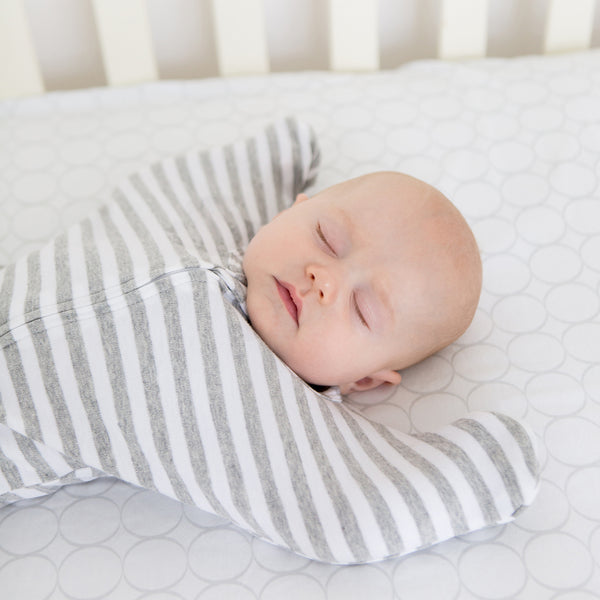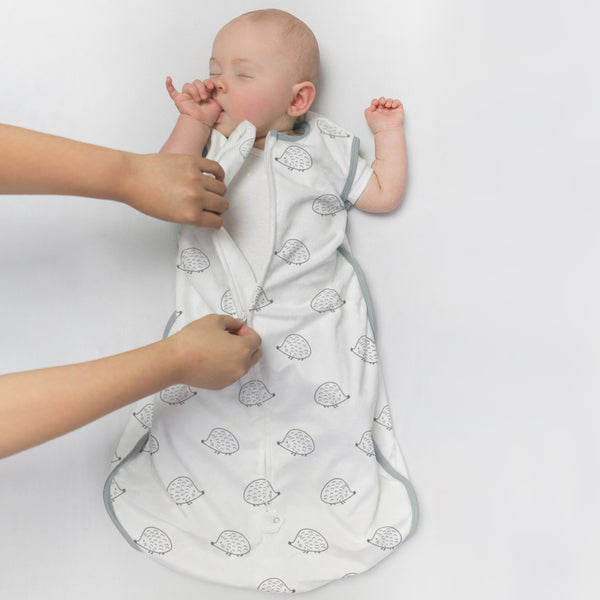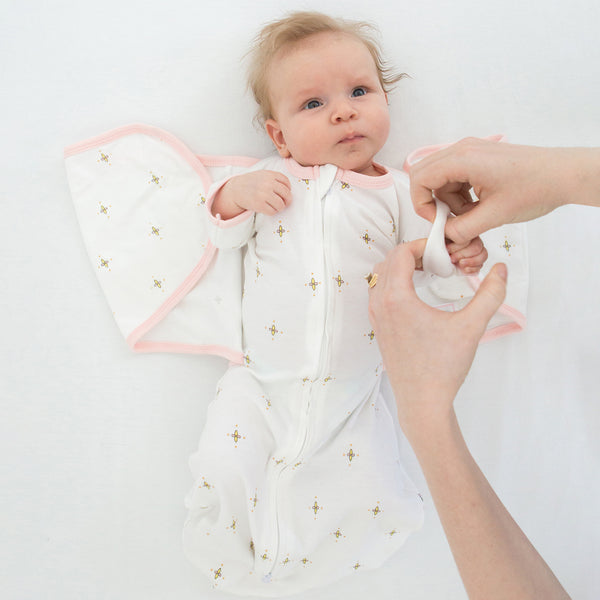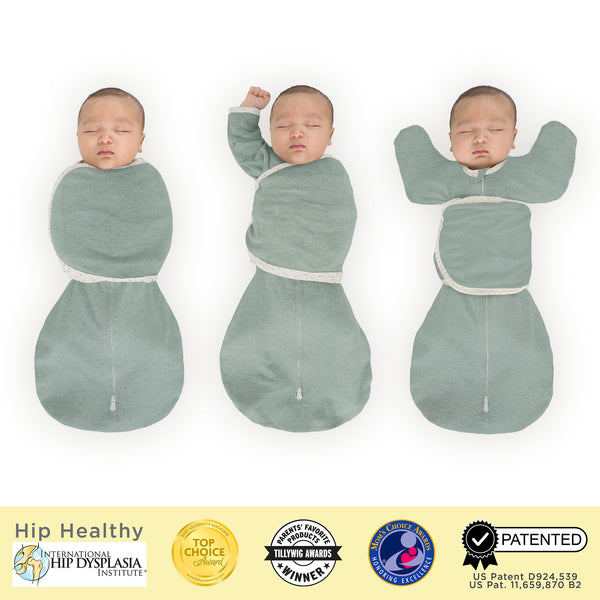Hospitals Deliver the Ultimate New Parent Departure Gift:
Better, Safer Sleep for Mom and Baby
Over the past year, many hospitals have updated their Safe Sleep programs to include in-hospital modeling of safe sleep and a take-home gift like a swaddling sack that helps the parents swaddle at home. This approach, combined with improved Safe Sleep educational material, increases the likelihood that new parents will recall, understand, and use safe sleep guidelines when they return home.
Recently, hospitals have decided to refresh and update their Safe Sleep program as they strive to maximize the impact of their program. They realize that parents are overwhelmed with emotion during their hospital stay, and it is very important to extend the educational program to the home. By providing a Safe Sleep take-home gift, they are providing a helpful tool and visual reminder of the hospital safe sleep educational material.
The programs are designed to educate parents about the American Academy of Pediatrics (AAP) Safe Sleep Guidelines and teach important newborn calming techniques including how to swaddle, so everyone can get more sleep. The goal is to empower parents with useful skills and tools, to minimize the probability that the parents will become overly fatigued and sleep deprived.
Sleep deprivation
Families where the baby is not sleeping well, struggle, because when baby is not sleeping well, nobody sleeps well. New parents need to learn how to properly swaddle a baby, because swaddling reduces the likelihood the baby will wake due to the Moro (startle) reflex. Studies have proven that swaddled babies sleep longer and better.
Sleep deprivation and exhaustion are the primary complaint of new parents and experts understand that parent sleep deprivation can lead to unsafe choices, increased postpartum depression and shaken baby syndrome.
Exhaustion combined with a crying baby impairs judgement and can lead parents to make unsafe choices such as bringing baby to bed with them, which significantly increases the risk of suffocation and SIDS. Or, they might opt to put baby on their stomach, which also significantly increases the risk of SIDS.
Given that 3,500 babies die annually in the United States as a result of SIDS, SUID, and suffocation, it is extremely important for hospitals to implement programs that reduce the likelihood that a parent will make unsafe sleep choices. While there is no way to prevent SIDS, there are AAP guidelines designed to reduce risk of SIDS, SUID and suffocation.
In-hospital modeling of Safe Sleep practices
Studies have shown that parents remember and mimic what nurses do at the hospital, and hence, hospitals understand that modeling safe sleep behaviors and using an easy, safe swaddling approach is important.
As a result, many hospitals implement Safe Sleep Modeling Programs in the birth center and NICU. Staff training is a critical element of the program. In addition to educational material provided to parents, the Safe Sleep programs often include swaddling blankets or swaddling garments as departure gifts.
In many hospitals, babies are placed on the mother’s chest for the first hour or two, and then swaddled to give the mother a break and help with temperature regulation as the baby transitions from the womb to the world.
Many hospitals have stopped using traditional hospital swaddle blankets to instead swaddle newborns in wearable blankets with swaddle wraps to make it easier and safer for new parents.
At Franciscan Health Indianapolis, for example, every infant is dressed and wrapped with an Omni Swaddle Sack after birth. The swaddling garment is used to swaddle the baby while in the hospital, and the discharge nurse gives an Omni Swaddle Sack as a departure gift to the parents.
The hospital, which delivered more than 2300 babies in 2018, has made a concerted effort to focus on Safe Sleep issues, in part due to the high infant mortality rate in Indiana.
This focus includes extensive education, in-hospital modeling of proper swaddling techniques and participation in programs such as the National Safe Sleep Certification program.
“Nurses are viewed as experts, so we need to make sure that we are following the safest sleep practices possible and modeling what parents are learning in the educational materials we provide,” says Jennifer Naessens RN, clinical manager of the post-partum unit and newborn nursery at Franciscan Health Indianapolis.
“We use the Omni Swaddle Sack in our hospital so we can teach and simulate safe sleeping habits for parents,” says Naessens. “The item ultimately goes home with the baby as a departure gift, so it can continue to be used in the home.”
Designed by Lynette Damir, RN, the Omni Swaddle Sack is convertible and supports many natural arm and hand positions. The product is designed with special, modified sleeves with foldover mitten cuffs that, when open, allow baby to self-soothe and, when closed, protect against facial scratches. The product includes an easy to adjust fabric wrap secured by hook-and-loop fasteners.
The sleeves are slightly shorter than a typical sleeve, so when the mitten cuffs are closed it holds the baby’s arms close to their body. If the baby prefers one or both arms up, then the sleeves cover the baby’s arms.
To support hospital safe sleep initiatives, SwaddleDesigns offers a special version of the Omni Swaddle Sack for in-hospital use, which has a longer wrap and does not use hook-and-loop fasteners. Nylon snaps are used instead of a zipper, to allow hospital personnel to x-ray without undressing the baby.
Naessens adds that even babies that stay in the NICU for an extended period are swaddled. “It is another opportunity for us to model the behavior,” says Naessens. “We want parents to see the consistency all along the line.”
Safe Sleep education
In addition to modeling swaddling techniques, education plays a critical role as well. At Franciscan Health Indianapolis, the hospital provides written and verbal instructions on Safe Sleep guidelines. For parents that have questions, or are struggling, a direct phone number to a Charge Nurse is provided.
Hospitals are also updating their Safe Sleep educational materials to include the “3 Stages of the Safe Sleepwear” framework to help parents understand the importance of the transitional phase between swaddling and the time baby is ready for loose, wearable blankets.
It is important that baby continue to sleep well during this transition time. The (AAP recommends parents stop swaddling baby with arms restrained at 2-3 months or when baby shows signs of attempting to roll over.
However, at three months of age, some babies are not ready and do not sleep well in the looseness of a wearable blanket and still need some suppression of the Moro reflex. When baby is not sleeping well, parents are more likely to try unsafe sleep practices such as continuing to swaddle or bringing baby to bed with them, which increases the risk of SIDS, SUID, and suffocation
A Transitional Swaddle Sack can help parents navigate this difficult period. A snug fitting design that partially suppress the Moro reflex, because the baby’s arms are slightly restrained, but allows sufficient range of motion for baby to use his or her arms to lift their torso and reposition their head, if he or she rolls over.
Departing gifts
According to Naessens, giving a departure gift that was first modeled by nurses in the hospital helps ensure parents are more prepared to apply Safe Sleep practices at home, which will reduce the frequency of sleep related incidents.
“We felt there was a critical need to send families home with swaddling garments for the safety of the infants born at our hospital,” explains Naessens. “We are always trying to impress upon parents how vulnerable babies are when they first go home, and why it is so important to keep the environment as safe as possible.”
Another concern is the quantity of misinformation related to swaddling techniques that has been posted online, as well as advice from well-meaning family members that may have outdated concepts of baby care not aligned with best practices or current safety standards.
Advertising from baby product manufacturers can also be misleading, says Naessens, with images of cribs for infants filled with stuffed animals and big, fluffy blankets.
“We try to teach families to use the education they get from their healthcare providers, because it is the most accurate information,” says Naessens.
Through education and modeling of Safe Sleep techniques, along with a departure gift that matches what was used by the nursing staff, hospitals will reinforce what parents learned so that it can be properly applied in the home.
In doing so, baby is safer and sleeps more soundly. So will parents, who armed with more sleep and better tools, find they will struggle less and make better choices. Ultimately, it should save lives.
Learn more about our Safe Sleep Programs for Hospitals
Please contact us at 855-SWADDLE or Hospital-info@SwaddleDesigns.com




